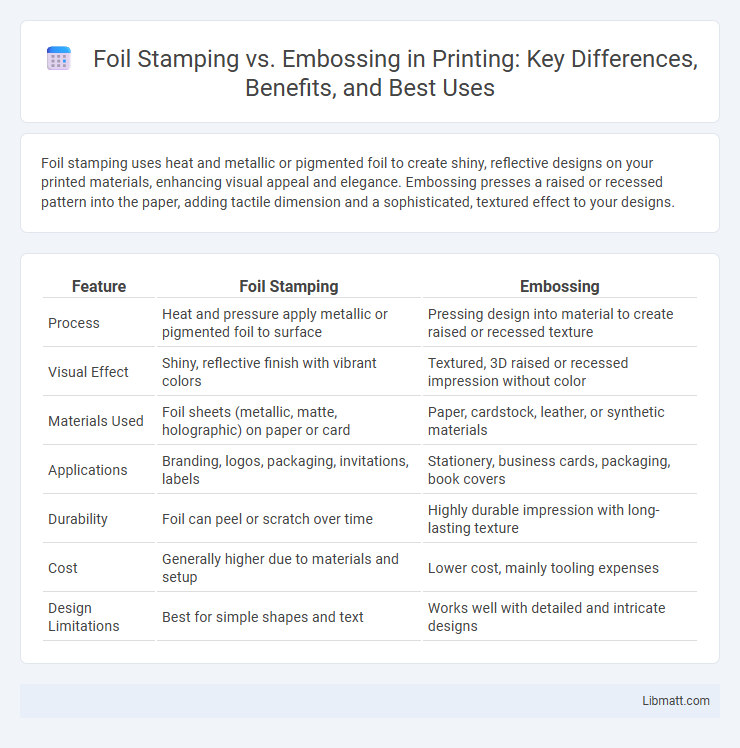Foil stamping uses heat and metallic or pigmented foil to create shiny, reflective designs on your printed materials, enhancing visual appeal and elegance. Embossing presses a raised or recessed pattern into the paper, adding tactile dimension and a sophisticated, textured effect to your designs.
Table of Comparison
| Feature | Foil Stamping | Embossing |
|---|---|---|
| Process | Heat and pressure apply metallic or pigmented foil to surface | Pressing design into material to create raised or recessed texture |
| Visual Effect | Shiny, reflective finish with vibrant colors | Textured, 3D raised or recessed impression without color |
| Materials Used | Foil sheets (metallic, matte, holographic) on paper or card | Paper, cardstock, leather, or synthetic materials |
| Applications | Branding, logos, packaging, invitations, labels | Stationery, business cards, packaging, book covers |
| Durability | Foil can peel or scratch over time | Highly durable impression with long-lasting texture |
| Cost | Generally higher due to materials and setup | Lower cost, mainly tooling expenses |
| Design Limitations | Best for simple shapes and text | Works well with detailed and intricate designs |
Understanding Foil Stamping and Embossing
Foil stamping uses heat and pressure to apply colored or metallic foil onto a surface, creating a shiny and reflective design, while embossing presses an image or pattern into the material to create a raised, tactile effect. Both techniques enhance packaging, invitations, and branding by adding visual and textural appeal, but foil stamping emphasizes color and shimmer, whereas embossing focuses on depth and dimension. Choosing between foil stamping and embossing depends on the desired aesthetic impact, material type, and project budget.
Key Differences Between Foil Stamping and Embossing
Foil stamping applies a metallic or pigmented foil to a surface using heat and pressure, creating a shiny, reflective design that stands out visually. Embossing, by contrast, raises a design above the paper or material surface, producing a tactile, three-dimensional effect without color change. Key differences include foil stamping's reliance on color and shine for impact, while embossing emphasizes texture and depth, often used together for combined visual and tactile appeal.
How the Foil Stamping Process Works
Foil stamping uses heat, pressure, and metallic or pigmented foil to create a shiny, reflective design on paper or other surfaces. A heated die presses the foil onto the substrate, melting the foil's adhesive layer and transferring the foil to the surface in the desired pattern. This process produces crisp, vibrant metallic effects not achievable through embossing, which primarily creates texture and raised impressions without added color or shine.
The Mechanics of Embossing Techniques
Embossing techniques involve creating raised or recessed designs on materials by pressing them between matched male and female dies, which shape the substrate using heat and pressure. The process can include blind embossing, where no ink or foil is applied, or registered embossing, which aligns precisely with printed elements. Foil stamping differs by first applying a metallic or pigmented foil onto the surface through heat-activated adhesive before or after embossing to add color and texture, enhancing visual appeal.
Visual and Tactile Effects Compared
Foil stamping delivers vibrant, metallic finishes that catch light and create eye-catching visual appeal, while embossing adds depth and texture by raising the surface of the material, giving a tactile dimension. Foil stamping's shiny, reflective qualities enhance logos or text, making them stand out, whereas embossing invites touch, adding sophistication and elegance through physical impression. Choosing between these techniques depends on whether your design requires striking color brilliance or subtle, textured enhancement.
Material Suitability: Foil Stamping vs Embossing
Foil stamping is ideal for smooth, rigid materials such as coated paper, cardstock, and synthetic substrates, where it adds metallic or pigmented foil layers with precision. Embossing works best on thicker and more textured materials, including heavy paper stock and leather, creating a raised or recessed relief without altering surface color. Your choice depends on material compatibility and desired visual or tactile effect, with foil stamping offering vibrant, reflective finishes and embossing providing dimensional depth.
Cost Analysis: Which Technique Is More Affordable?
Foil stamping generally incurs higher costs due to the specialized metallic or pigmented foils and the precise temperature and pressure controls required during application. Embossing tends to be more affordable, relying primarily on creating raised or recessed designs through dies without additional materials like foil. For large-volume projects, embossing offers better cost efficiency, whereas foil stamping may justify its premium for premium finishes or brand differentiation.
Design Flexibility and Limitations
Foil stamping offers vibrant color options and metallic finishes, allowing intricate patterns and fine details that enhance your design's visual impact. Embossing creates raised textures for a tactile experience but may limit the complexity of designs due to depth and pressure constraints. Understanding these differences helps you choose the technique that best balances aesthetic appeal with practical feasibility in your project.
Common Applications Across Industries
Foil stamping is widely used in packaging, luxury branding, and marketing materials to create eye-catching metallic or holographic effects that enhance product appeal. Embossing finds common applications in stationery, book covers, and leather goods, adding tactile texture and depth to enhance the perceived quality and sophistication. Your choice depends on whether you want to emphasize visual shine with foil stamping or a raised, tactile impression with embossing.
Choosing the Right Technique for Your Project
Foil stamping offers vibrant metallic finishes that enhance brand visibility, making it ideal for luxury packaging and invitations requiring a high-impact gloss. Embossing creates a tactile, raised texture that adds depth and elegance, perfect for business cards and stationery seeking a subtle yet sophisticated look. Selecting the right technique depends on the desired visual effect, material compatibility, and project budget for optimal results.
Foil stamping vs embossing Infographic

 libmatt.com
libmatt.com